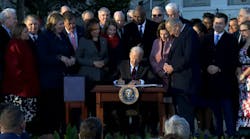OP-ED: Paying the technical debt
In my last piece, I discussed how our built infrastructure tells us the most convenient option is to travel by private car. This time, we’ll talk about how the information systems– the transportation information infrastructure, if you will– are disconnected, and why we need to connect them to give people more options.
Creating a cohesive, interoperable transportation information system with data standards that allows information to flow across various private sector services and within government agencies is a key step in making shared mobility a more convenient option. It will also help to make it more affordable. Making shared mobility more affordable and convenient through a better flow of information will help us fight climate change and address inequality.
A prime example of what can happen when not only transportation options are limited but also the technology infrastructure that runs these modes is siloed and outdated was on full display over the holidays with the Southwest Airlines debacle that left hundreds of thousands of people stranded. Though it’s been used in tech circles for a while, this incident was disruptive enough to introduce a new term to the everyday consumer’s vocabulary. Zeynep Tufecki, writing for the New York Times, called it “technical debt.” The gist is Southwest failed to invest in and update the software and computer systems that handles all its scheduling. This led to a cascading series of failures that led to the holiday catastrophe.
When we fail to see information as critical infrastructure, we fail to plan and fail to invest, thus incurring technical debt, and technical debt is not unique to Southwest or the aviation industry. There is technical debt that spans across our urban transportation systems, stemming from antiquated systems that can’t integrate or talk to one another. Putting off technology investments and integrations may save organizations money on the front end, but it’s the people who these organizations serve that become collateral damage and pay the price. The lack of interoperability inhibits our communities and individuals from moving successfully and freely using shared mobility; it keeps us from making shared mobility options “more reliable, easier to use, and more available, more equitable and accessible, more environmentally sustainable and more economically sustainable than driving a car.”
And while the shared mobility sector has seen significant progress when it comes to technology platforms such as those for ridesharing, trip planning and fare integration, the smooth user experience abruptly ends when users have to bounce between platforms. In other words, we’re still missing the interoperability of these tools. There has been lots of talk about Mobility-as-a-Service (MaaS), cross-platform systems that allow the user to book any mode and connect all their trips, but we have yet to see a really successful implementation.
The Shared Mobility 2030 Action Agenda recognizes the value these tools and platforms provide individually but emphasizes that without the proper flow of information across services and organizations, riders will constantly be left with needing more. The agenda states, “Most of our information systems are still a patchwork and don’t work as seamlessly as they should to make shared mobility more reliable, available, accessible and easier to use. Our systems are not interoperable (yet), and we don’t have clear strategies and plans for how we will build and interconnect information systems.”
This was clear to me when I served in the department of transportation of a major U.S. city. Our internal information systems were all siloed. Getting data from one system to another required printing out the data into a spreadsheet and then manually uploading the data to the other system. The system that controlled traffic lights only produced data in PDF's.
Worse, there was no clear plan for building a cohesive transportation information system. Some units had their own technology roadmaps, but there was no plan for the whole (We proposed a transportation information infrastructure plan, but that was ignored by the leadership and the mayor.) Because we didn’t have a plan, we couldn’t mobilize our information systems to decarbonize the transportation system, nor could we target our information to help us address inequality and racial discrimination.
However, there is some promising movement. Groups like Mobility Data and Open Mobility Foundation are stewarding data standards that allow governments and private companies to share data in real-time. A coalition of private companies and public agencies are committed to the Mobility Data Interoperability Principles. These efforts will hopefully gain momentum, but they won’t get much traction if the agencies don’t have the resources and the technical capacity to build internal systems that allow information to flow.
There is more good news. The recently passed Bipartisan Infrastructure Law provides $160 million annually for the next five years for projects that use technology to improve transportation infrastructure and make communities safer. It’s a start, but it’s probably not near enough to begin paying the growing technical debt in our urban transport systems.
This dedicated funding is crucial, as is the coalition building that Mobility Data, Open Mobility Foundations and Mobility Data Interoperability Principles are working towards. However, as the Action Agenda indicates, we need industry-wide buy-in, and we need cross-sector collaboration to agree on and implement shared goals and interests when it comes to the technology systems we use for shared mobility.
The very first step to getting out of debt is to admit that we are in debt. The very first step in getting out of the hole is to stop digging.
---------------
Benjie de la Peña is CEO of Shared-Use Mobility Center.

Benjie de la Peña | CEO, Shared-Use Mobility Center (SUMC)
Benjie de la Peña is the CEO of the Shared-Use Mobility Center; he chairs the Global Partnership for Informal Transportation; founder of Agile City Partners; and writes and curates Makeshift Mobility, a fortnightly newsletter covering innovations in informal transportation. He also convenes the Shared Mobility 2030 Action Agenda and edits and produces Pop Transport.
He serves on the board of the American Council for an Energy-Efficient Economy (ACEEE), the U.S. Advisory Committee of the Institute for Transportation and Development Policy, the UITP Informal Transportation Working Group, the Digital Transport for Africa Partners Committee, the MobiliseYourCity Steering Committee and is a senior fellow for mobility for the Canadian Urban Institute.
He served as the first-ever chief of strategy and innovation for the Seattle Department of Transportation. He and his team drafted the city’s Transportation Information Infrastructure Plan. He also led the development of Seattle’s New Mobility Playbook.
He served on the advisory committees for L.A.’s Transportation Technology Strategy, the Mobiprize and Cooper Hewitt Museum’s The Road Ahead: Reimagining Mobility and Design with the Other 90%: Cities.





